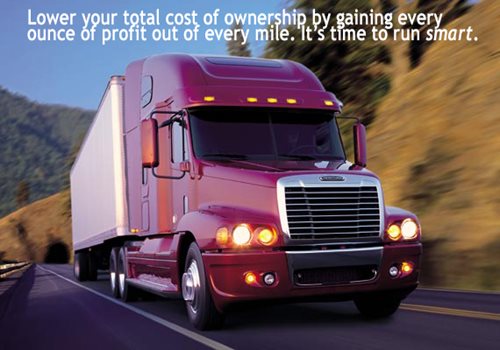
Total Cost of Ownership (TCO) is an increasingly more common term heard from Original Equipment Manufacturers (OEMs). So what does TCO really mean? Put simply, TCO is your total cost of doing business. For owner-operators and fleet owners, lowering your TCO means gaining every ounce of profit out of every mile while reducing costs to increase savings. It’s how to “Run Smart.”
The first step to knowing how to lower your TCO is figuring out what your TCO actually is. Your TCO is similar to your total cost per mile. Figuring out your cost per mile means calculating all of your expenses (fixed and variable) per month and dividing that by the number of miles you drove in a month. A good accounting system should be in place to help you obtain this number. If you need assistance figuring your cost per mile, a company like ATBS, who specializes in taxes, accounting and bookkeeping for truckers, can help you. Once you have this number you can look at ways to lower your cost per mile or your TCO.
There are many factors that can contribute to lowering your TCO. Below are our Top 5 ways to lower your TCO.
- Drive a Fuel-Efficient Truck. When fuel is your highest variable business cost, fuel efficiency is a must. A truck with cutting-edge, fuel-efficient technology can save you thousands of dollars each year. For example, Henry Albert, Team Run Smart Pro, has consistently achieved over 10.00 MPG in his 2013 Freightliner Cascadia Evolution. If you are driving an older or less fuel-efficient truck, it’s likely you get between 6-8 MPG. This difference in 2-4 MPG could mean $20,000 or more back in your pocket from fuel savings. Some of the new fuel-efficient technologies the Cascadia Evolution features are the Run Smart Predictive Cruise™ and the innovative ParkSmart™ battery-powered HVAC system. The Run Smart Predictive Cruise system combines the latest GPS technology with digital mapping for 3D profiles of the road ahead and results in significant fuel savings. The ParkSmart HVAC system integrates emissions-free cooling and highly efficient heating, without engine idling.
- Find Your Sweet Spot. The sweet spot is the best RPM to run your engine so it’s the most efficient. The trick is pulling your load with torque and not horsepower. When you pull with horsepower, you use more energy, and therefore burn more fuel to pull your load. We have consistently found somewhere between 1250 - 1350 RPM is the magic number, but check with your engine manufacturer.
- Maximize Your Uptime. A hard-to-service truck can be costly and timely to repair. With Detroit™ Virtual Technician™ you can monitor every aspect of how your Detroit truck engine is running, allowing for real-time maintenance notifications or scheduling service remotely when needed. Also, make sure your truck has a great service network to keep you on the road, no matter where you are. The Freightliner Cascadia has fewer parts, made easier to reach and service throughout the entire truck. There’s a long list of reliable components and thoughtful design details that keep the Cascadia driving on. Freightliner’s service programs also keep you driving. These include full-service maintenance solutions that operate on flexible scheduling, rapid breakdown response to get you in for repairs more quickly, and budgeting advice to ensure servicing your vehicle doesn’t keep you off the road too long.
- Perform Preventative Maintenance. Preventative maintenance (PM) can be expensive, but neglect is even more costly. Systematic PM saves you money in the long run by reducing the chances of equipment failure on the road and reducing time lost to repairs.
- Save for (and Pay) Taxes. Quarterly self-employed taxes are due on the 15th of April, June, September, and January. Those who don’t pay their estimated self-employment tax will be subject to an interest penalty. If you have fallen behind on estimated tax payments, you can stop accruing interest by making an estimated payment that brings you up to date. Going forward, interest will not be owed, as long as you continue to make payments. You can’t protect yourself against penalties by waiting until the end of the year and making a large estimated payment.
Lowering your TCO means you are running smart and efficient. Follow the list above to keep your total cost of doing business low, and your profits high.